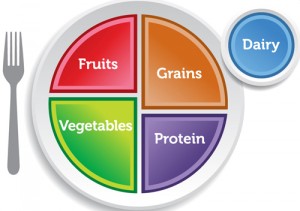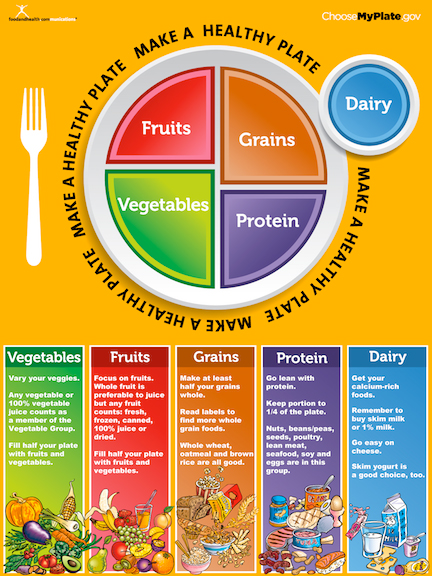By Rachel Berman RD, Director of Nutrition at CalorieCount.com
Last month, the USDA celebrated its one year anniversary of releasing MyPlate to replace the decades-old food guide pyramid in order to help Americans make healthier choices at mealtime. In case you haven’t seen it yet, MyPlate is a visual representation of what your plate should look like, sectioned off with 50% attributed for fruits and vegetables, 30% grains, 20% protein and a smaller circle next to the plate representing dairy. But is the government implementing this nutrition guide focusing on balance when it comes to the National School lunch program? With more than one-third of the nation’s children and adolescents being obese and students taking in about 20-50% of their daily food at school during the school year, is the math adding up to more nutritious school lunches?
 This year, the USDA is requiring a revamp of school lunches due to first lady Michelle Obama’s initiative and as a component of the Healthy Hunger-Free Kids Act signed by the president. Beginning July 1, 2025, new school lunch and general nutrition standards started rolling out and will continue for the next five years. The main changes, which are in line with MyPlate recommendations, include ensuring:
This year, the USDA is requiring a revamp of school lunches due to first lady Michelle Obama’s initiative and as a component of the Healthy Hunger-Free Kids Act signed by the president. Beginning July 1, 2025, new school lunch and general nutrition standards started rolling out and will continue for the next five years. The main changes, which are in line with MyPlate recommendations, include ensuring:
- Kids are offered fruits and veggies every day
- Offered more whole grains
- Only low fat or fat free milk
- Monitored calorie counts based on age to limit portions
New guidelines are also placed on cutting down on sodium and reducing content in meals even further over the next decade. Even though tomato paste may still be considered a vegetable by Congress, there will be weekly requirement for servings of leafy greens, red/orange and starchy veggies, and legumes to offer more nutrients and variety. The USDA published this chart, which compares a sample lunch before and after the new guidelines go into effect.
In addition to actual meal changes, the government will provide schools with an additional six cents per meal, which is the first real change in funding in 30 years and is correlated with improved meal quality. Also, nutrition standards will extend outside the lunchroom to vending machines where kids often have access to a bevy of saturated fat and sodium-laden snack foods. Those will disappear along with the mystery meat in the lunch room. There will also be restrictions imposed for funding from non-federal sources to ensure these healthy standards aren’t compromised. For example, perhaps major soft drink companies may no longer be able to fund building of the school gym in exchange for installing vending machines offering their beverages.
Since obese children are likely to be obese as adults with an increased risk for diseases like type 2 diabetes and heart disease, helping the 32 million children involved in school lunch eat healthier foods can potentially have a significant impact on our nation’s health. We have a long road ahead of us as far as combating the obesity epidemic but as the first lady said in a statement earlier this year, “As parents, we try to prepare decent meals, limit how much junk food our kids eat, and ensure that they have a reasonable balanced diet. And when we are putting in all that effort the last thing we want is for our hard work to be undone each day in the school cafeteria.”
 Also Read:
Also Read:
5 Balanced Dinner Menus to Fill Your MyPlate
The Other Food Pyramid: What Harvard’s Has that MyPlate Doesn’t
Lessons in Proper Nutrition: Teaching MyPlate in the Classroom
